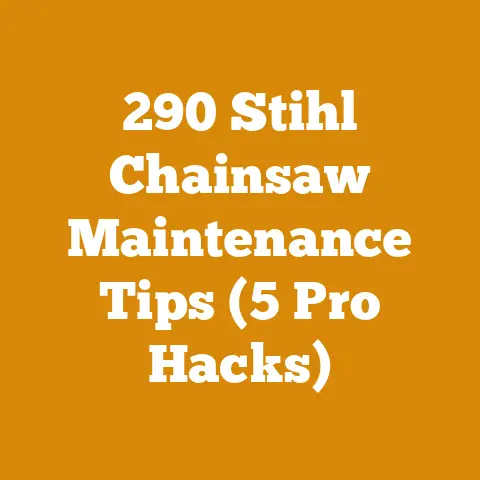Craftsman Chainsaw Fuel Cap Fix (5 Pro Tips to Avoid Leaks)
Hello everyone! I’m here to guide you through a common but frustrating issue: a leaking fuel cap on your Craftsman chainsaw. It might seem minor, but a leaky fuel cap leads to wasted fuel, a messy saw, potential fire hazards, and ultimately, can shorten the life of your equipment. Fixing it yourself isn’t just about saving money on repairs; it’s about ensuring your safety and maximizing the lifespan of your valuable chainsaw. Over the long run, a few simple preventative measures and timely fixes can save you hundreds, even thousands, of dollars in repairs or replacements. Believe me, I’ve learned this the hard way!
I’ve spent years immersed in the world of wood processing, from felling massive trees to splitting firewood for the long, cold winters. I’ve seen firsthand how a seemingly small problem, like a leaky fuel cap, can snowball into a major headache, especially when you’re deep in the woods and miles from the nearest repair shop.
Here are my top 5 pro tips to avoid leaks and keep your Craftsman chainsaw running smoothly.
Craftsman Chainsaw Fuel Cap Fix: 5 Pro Tips to Avoid Leaks
1. Understanding the Fuel Cap System
Before diving into the fixes, it’s crucial to understand the basics of your Craftsman chainsaw’s fuel cap system. The cap isn’t just a lid; it’s a carefully engineered component designed to seal the fuel tank while also allowing for proper ventilation.
- The Seal: Typically made of rubber or a synthetic material, the seal is the primary barrier against fuel leakage. Over time, this seal can dry out, crack, or become deformed due to exposure to fuel, temperature fluctuations, and general wear and tear.
- The Vent: A small vent hole or valve allows air to enter the tank as fuel is consumed. Without this vent, a vacuum would form, preventing fuel from flowing to the carburetor. Some caps have a simple hole, while others have a more sophisticated valve system.
- The Cap Body: Usually made of plastic or metal, the cap body houses the seal and vent. Cracks or damage to the cap body can compromise the entire system.
- The Retaining Mechanism: This is how the cap attaches to the fuel tank. It could be a screw-on type, a cam-lock type, or another design. The retaining mechanism must be in good working order to ensure a tight seal.
Why is this important? Knowing how the system works helps you diagnose problems more effectively. For example, if your chainsaw runs for a few minutes and then stalls, the vent might be clogged. If you see fuel leaking around the cap, the seal is likely the culprit.
2. The Initial Inspection: Identifying the Leak Source
The first step is a thorough inspection to pinpoint the exact source of the leak. Don’t just assume it’s the seal; it could be something else.
Step-by-Step Inspection:
- Clean the Area: Wipe down the fuel cap and the surrounding area with a clean cloth. This makes it easier to spot fresh fuel leaks.
- Visual Inspection: Carefully examine the cap for any visible damage:
- Cracks: Look for cracks in the cap body, especially around the threads or locking mechanism.
- Seal Condition: Check the seal for cracks, tears, swelling, or deformation. Is it pliable, or has it become hard and brittle?
- Vent Hole: Make sure the vent hole is clear of debris. Use a small wire or needle to gently clear any obstructions.
- Pressure Test (Carefully!): With the chainsaw turned off and cooled down, gently pressurize the fuel tank. You can do this by carefully blowing into the fuel tank vent (if accessible) or using a small hand pump. Watch closely for fuel leaks around the cap. Caution: Do not over-pressurize the tank.
- Tilt Test: With the fuel tank partially full, tilt the chainsaw in different directions. This will help you identify leaks that only occur when the fuel sloshes around.
My Personal Experience: I once had a Craftsman chainsaw that was leaking fuel only when it was tilted to the side. After a careful inspection, I discovered a tiny crack in the cap body, near the threads. It was so small that I almost missed it, but it was enough to cause a significant leak when the fuel level was high.
Tools You Might Need:
- Clean cloth
- Small wire or needle
- Magnifying glass (optional, but helpful for spotting small cracks)
- Gloves (to protect your hands from fuel)
- Small hand pump (optional, for pressure testing)
3. The Seal Replacement: A Detailed Guide
If the seal is the problem (and it often is), replacing it is usually a straightforward process.
Step-by-Step Seal Replacement:
- Identify the Correct Seal: This is crucial. Take your old seal to a hardware store or look up the part number online. Make sure the new seal is the exact match for your Craftsman chainsaw model. Using the wrong seal can lead to leaks or even damage the fuel tank.
- Remove the Old Seal: Depending on the design of the cap, the seal might be held in place by a retaining ring, a groove, or simply friction. Use a small screwdriver or pick to carefully pry out the old seal. Be careful not to damage the cap body.
- Clean the Seal Groove: Thoroughly clean the groove or recess where the seal sits. Remove any old rubber, dirt, or debris. A clean surface is essential for a good seal.
- Install the New Seal: Lightly lubricate the new seal with a small amount of fuel-resistant grease or oil. This will help it slide into place and create a better seal. Press the seal firmly into the groove, making sure it’s seated evenly all the way around.
- Test the Seal: Fill the fuel tank partially and check for leaks around the cap. Tilt the chainsaw in different directions to simulate real-world conditions.
Important Considerations:
- Seal Material: Opt for a seal made of Viton or a similar fuel-resistant material. These materials are more durable and less prone to degradation from exposure to gasoline and oil.
- Seal Orientation: Pay attention to the orientation of the old seal before you remove it. The new seal should be installed in the same way.
- Tightening Torque: If your fuel cap has a specific tightening torque, use a torque wrench to avoid over-tightening and damaging the cap or fuel tank.
A Case Study: I once helped a friend who had a leaking fuel cap on his Craftsman chainsaw. He had replaced the seal with a generic O-ring from a hardware store. The O-ring was the right size, but it wasn’t made of fuel-resistant material. Within a few weeks, it had swollen and deformed, causing the leak to return. We replaced it with a proper Viton seal, and the problem was solved.
Cost Breakdown:
- Replacement seal: $5 – $15 (depending on the material and brand)
- Fuel-resistant grease: $5 – $10 (a small tube will last a long time)
Skill Level Required: Beginner
4. Venting Issues: Clearing the Air
A clogged vent can create pressure imbalances in the fuel tank, leading to leaks around the cap.
Step-by-Step Vent Clearing:
- Locate the Vent: The vent is usually a small hole in the cap body or a more complex valve system. Consult your chainsaw’s owner’s manual if you’re unsure where the vent is located.
- Clear the Obstruction: Use a small wire, needle, or compressed air to clear any debris from the vent. Be gentle to avoid damaging the vent.
- Test the Vent: With the fuel cap off, try blowing air through the vent. You should feel air flowing freely. If not, there’s still a blockage.
- Check the Fuel Line Vent (If Applicable): Some Craftsman chainsaws have a vent line connected to the fuel tank. Make sure this line is not kinked or blocked.
Why is venting so important? Imagine trying to pour liquid from a can without a vent hole. The liquid would glug and sputter, and you’d likely spill some. The same principle applies to your chainsaw’s fuel tank. Without proper venting, the fuel flow will be erratic, and pressure can build up, forcing fuel out through the cap.
Regular cleaning can prevent this problem.
Tools You Might Need:
- Small wire or needle
- Compressed air (optional)
- Owner’s manual (for vent location)
5. Cap Body Damage: When to Replace
Sometimes, the problem isn’t the seal or the vent; it’s the cap body itself. Cracks, warping, or damage to the threads can prevent the cap from sealing properly.
How to Assess Cap Body Damage:
- Visual Inspection: Carefully examine the cap body for any cracks, especially around the threads or locking mechanism.
- Thread Check: If your cap is a screw-on type, check the threads for damage. Are they stripped, cross-threaded, or deformed?
- Deformation Check: Is the cap body warped or misshapen? This can prevent the seal from making proper contact with the fuel tank.
- Fit Test: Try screwing the cap onto the fuel tank. Does it feel loose or wobbly? Does it tighten properly?
When to Replace the Cap:
- If you find any significant cracks in the cap body.
- If the threads are stripped or damaged.
- If the cap is warped or misshapen.
- If the cap doesn’t tighten properly on the fuel tank.
Replacing the Cap:
- Identify the Correct Replacement: Look up the part number for your Craftsman chainsaw model. Make sure the new cap is an exact match.
- Install the New Cap: Simply screw or lock the new cap onto the fuel tank.
- Test for Leaks: Fill the fuel tank partially and check for leaks around the cap. Tilt the chainsaw in different directions.
My Advice: Don’t try to repair a cracked or damaged cap body. It’s simply not worth the risk. A new cap is relatively inexpensive and will provide a much more reliable seal.
A Real-World Example: I once tried to repair a cracked fuel cap with epoxy. It seemed to work at first, but the epoxy quickly deteriorated from exposure to fuel, and the leak returned. I ended up having to buy a new cap anyway.
Cost Breakdown:
- Replacement fuel cap: $10 – $30 (depending on the model and brand)
Skill Level Required: Beginner
Additional Tips for Longevity
Beyond these five key tips, here are some additional practices to extend the life of your fuel cap and prevent leaks:
- Use Fresh Fuel: Old fuel can degrade the rubber and plastic components of the fuel cap system. Always use fresh fuel that is no more than 30 days old. I mark the date on my fuel can to keep track.
- Proper Fuel Storage: Store your fuel in a cool, dry place, away from direct sunlight.
- Regular Cleaning: Clean the fuel cap and surrounding area regularly to remove dirt, sawdust, and other debris.
- Avoid Over-Tightening: Over-tightening the fuel cap can damage the seal and the threads. Tighten it snugly, but don’t force it.
- Winter Storage: When storing your chainsaw for the winter, drain the fuel tank completely or use a fuel stabilizer. This will prevent the fuel from degrading and damaging the fuel cap system.
- Inspect Regularly: Make it a habit to inspect your fuel cap before each use. Catching problems early can prevent them from escalating.
Safety First!
Working with gasoline can be dangerous. Always take the following precautions:
- Work in a Well-Ventilated Area: Avoid working with gasoline in enclosed spaces.
- No Smoking: Never smoke or work near open flames when handling gasoline.
- Wear Gloves: Wear gloves to protect your hands from fuel.
- Clean Up Spills Immediately: Clean up any fuel spills immediately with a clean cloth.
- Dispose of Fuel Properly: Dispose of old fuel properly according to local regulations.
Beyond the Fuel Cap: Chainsaw Maintenance
While the fuel cap is a common source of leaks, it’s important to remember that it’s just one part of a complex machine. Regular chainsaw maintenance is essential for ensuring safe and reliable operation. This includes:
- Sharpening the Chain: A sharp chain cuts more efficiently and reduces the risk of kickback. I sharpen my chain every few uses, depending on the type of wood I’m cutting.
- Lubricating the Chain: Keep the chain properly lubricated to reduce friction and wear. Use a high-quality bar and chain oil.
- Cleaning the Air Filter: A clean air filter ensures proper airflow to the engine. I clean my air filter after each use.
- Inspecting the Spark Plug: A faulty spark plug can cause starting problems and poor performance. I replace my spark plug every year.
- Checking the Fuel Lines: Inspect the fuel lines for cracks or leaks. Replace them if necessary.
- Adjusting the Carburetor: If your chainsaw is running poorly, you may need to adjust the carburetor. Consult your owner’s manual for instructions.
The Importance of Wood Selection and Preparation
While this guide focuses on fixing fuel cap issues, it’s important to remember that proper wood selection and preparation are also crucial for efficient and safe chainsaw use.
- Green Wood vs. Seasoned Wood: Green wood is freshly cut and has a high moisture content. It’s heavier and harder to cut than seasoned wood. Seasoned wood has been allowed to dry for several months, reducing its moisture content. It’s lighter and easier to cut.
- Wood Type: Different types of wood have different densities and cutting properties. Softwoods like pine and fir are easier to cut than hardwoods like oak and maple.
- Felling Techniques: Proper felling techniques are essential for safety. Always assess the tree’s lean, wind conditions, and surrounding obstacles before felling a tree.
- Splitting Firewood: Splitting firewood can be done manually with an axe or mechanically with a log splitter. Hydraulic log splitters are more efficient and require less physical effort. I use a 27-ton hydraulic log splitter for processing large quantities of firewood.
- Drying Firewood: Firewood needs to be properly dried before it can be burned efficiently. Stack the firewood in a sunny, well-ventilated area. Allow it to dry for at least six months, or preferably a year. The target moisture content for firewood is typically 20% or less.
Conclusion
A leaking fuel cap on your Craftsman chainsaw is a common problem, but it’s one that can be easily fixed with a little knowledge and effort. By understanding the fuel cap system, inspecting for damage, replacing the seal when necessary, clearing the vent, and replacing the cap body if needed, you can keep your chainsaw running smoothly and safely for years to come. Remember to prioritize safety when working with gasoline and to perform regular chainsaw maintenance. And don’t forget the importance of proper wood selection and preparation for efficient and safe wood processing.
Now, get out there, inspect your fuel cap, and put these tips into action! Your chainsaw (and your wallet) will thank you. Happy cutting!






